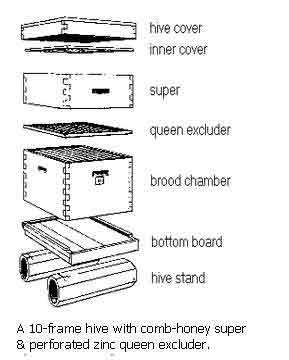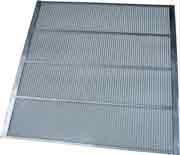The Hive and Its Parts

Honeybees can live in hollow trees, wall voids in buildings, attics, or any other protected place. Several types of hives have been designed to manage honeybees. Old-fashioned hives were simple devices, such as plain boxes, short sections of hollow logs called gums, or straw baskets called skeps. These hive styles have many disadvantages and are rarely used now. Combs in them were usually irregular and braced together with burr comb. Individual combs could not be removed from the hive without damaging other pieces or even injuring or killing the queen. It was also difficult to inspect the hives for diseases and other problems.

Modern hives with movable frames allow easy inspection and honey removal. Hive design is efficacious for other management practices and for the bees. The inner dimensions of the hive and its parts are very precise. They are based on a dimension called the "bee space," which is about 5/16-inch wide or deep. Proper spacing is important. If gaps are too wide, bees build brace comb and glue down movable frames. The modern hive consists of several parts.
A hive stand keeps the hive off the ground so it is less likely to rot, flood, or be attacked by termites. It can be as simple as a few bricks stacked under each hive corner, or it might be a wood frame with an alighting board. The alighting board allows heavily loaded field bees to land more easily before crawling into the hive.
The hive rests on the three rails of the bottom board. The open side is the hive entrance. This opening can be closed or narrowed with an entrance cleat when necessary. Reducing the entrance opening in the fall keeps out field mice looking for shelter. The standard hive body or brood chamber holds 10 frames of comb. Besides being the nursery, it is also pantry, kitchen, living room, dining room, bedroom, and workshop for the bees. If it becomes too crowded, the bees might begin rearing brood in the supers. If colonies get very large, provide extra hive bodies for the brood chamber.

A queen excluder is sometimes placed above the brood chamber to keep the queen in the brood chamber. Slots in the excluder are wide enough workers can go back and forth but too narrow for the queen to pass through. Beekeepers who produce extracted honey do not use excluders because they reduce the bees efficiency. For comb-honey and chunk honey production, the excluder assures that brood are not in the honey product.
Chambers above the brood chamber are called supers. They are the same size as the brood chamber and are used for storage of surplus honey. Deep supers are used by those who primarily produce extracted honey. Larger boxes require less handling but are heavy when full of honey. Shallow supers are easier to lift and convenient for harvesting small honey yields from a particular nectar source.
The inner cover is a flat piece with an oblong hole in the center. A bee escape can be put in the hole when needed. The hole provides ventilation and a place to puff smoke when opening the hive. The edges of the inner cover have railings on both faces. The railing on one side is higher than the other. The tall railing should be on the outside. If the tall rail is on the inside, the bees build wax between it and the tops of the frames. The buildup is a mess to clean.
The top cover is a waterproof lid that rests on the edges of the top super. Bees do not glue down the top cover, so it can be lifted from the hive without prying or jarring.
Frames are the inside parts that hold the comb. They consist of a top and bottom and two end bars. The wide part of an end bar is keeled on one edge. Place frames in the hive so that the keeled edge of one frame abuts the flat edge of the next one. Frames help keep comb-building regular and allow easy inspection and honey removal. All frames are the same length, but there are different depths and styles.
Carefully put together unassembled frames. Fit the frame together so that the keel on the left end bar is toward you and the keel on the right end bar is way from you. If you rotate the frame, the keel is still toward you on the left side and away from you on the right. Use plenty of nails when fastening the frame together. Otherwise, it can pull apart when the comb is full of honey.
To ensure that the comb is regular, frames are fitted with thin sheets of embossed wax called foundation. Foundation for brood frames and extracted honey frames has embedded wires for extra strength. This prevents the comb from sagging when the wax gets soft during hot weather or from tearing apart during extraction.
Foundation can be purchased with wires in it, or wire can be embedded after the foundation is fitted into the frame. It is more convenient for the beginner to buy wired foundation for brood frames. Use unwired foundation in the honey frames if you are going to produce chunk honey. The size of foundation sheets varies with frame size. Bee supply catalogs specify the frame styles different foundation sheets fit.






